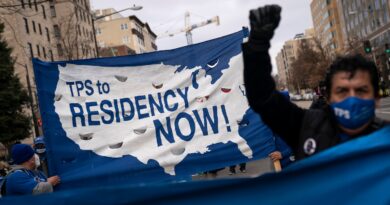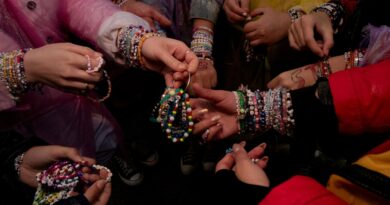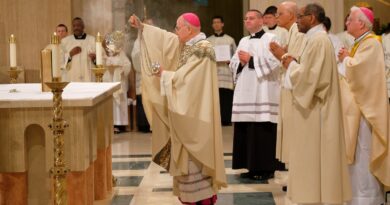What to know about the kaffiyeh, a symbol of the Palestinian cause
The checkered garment made headlines this month when a man shot and wounded three college students of Palestinian descent — two of whom were wearing kaffiyehs — on a quiet street in Burlington, Vt. Families of the victims said they feared the crime was fueled by hate; authorities told reporters they are still working to determine a motive.
The kaffiyeh, a fabric that in modern days is often worn as a scarf, comes in many colors. The black-and-white version has been associated with Palestinians for decades, according to Ted Swedenburg, a University of Arkansas professor who has studied the garment for over 40 years.
In the 1930s, Palestinians revolted against the British mandate for Palestine, years after Allied powers divvied up the defeated Ottoman Empire — Syria and Lebanon were given to France, and the British were mandated Palestine and Iraq. During a major Arab revolt in the 1930s, Swedenburg said, some rebel commanders ordered Palestinians in the cities of the British mandate to wear the kaffiyeh, leading a garment once worn mostly by farmers and rural peasants to routinely appear in urban areas as well.
Over the course of the 20th century, the kaffiyeh grew in prominence. Palestinian leader Yasser Arafat began wearing it in the 1960s, and Palestinian men donned it to disguise themselves while throwing stones at Israeli soldiers in the 1980s during the first intifada, according to Swedenburg. The kaffiyeh also started being seen as contentious by some who connected the headdress to the violence.
In the 1990s and 2000s, the kaffiyeh became a popular fashion item, while also becoming representative for some of struggles for liberation across the globe.
“It’s a cultural symbol that has taken on national significance for Palestinians,” said Khaled Elgindy, the director of the Middle East Institute’s Program on Palestine and Israeli-Palestinian Affairs. “At its core it’s just a traditional Arab scarf that’s become popularized because of the Palestinian struggle.”
A kaffiyeh is a traditional headdress worn through much of the Middle East. It can be styled as a scarf, wrapped around one’s head with a ring or draped around one’s shoulders. It can be checkered red or black or green, and can have different symbols on it that reflect the country in which it’s worn.
Saudi Arabia’s kaffiyeh, for example, looks different from that of Syria’s, which looks different from the one associated with Palestinians.
The kaffiyeh, however, predates many of the borders that exist today, said Nael Alqassis, the spokesperson for Hirbawi Kufiya, which claims to be the only remaining manufacturer of kaffiyehs in the West Bank. Originally, the large cloth served multiple purposes, Alqassis said, which included “keeping sun, sand and sweat off the faces of farmers.”
“They were used to transport farmers’ meals to the farms, or they could be sat or prayed upon when you were away from home,” he said.
Alqassis said that while there is no documentation on this, he believes that the black-and-white kaffiyeh only became popular in Palestine after the 1950s, when the clothing item began to be produced on mechanical looms, which worked better with limited colors.
“Before that, in old paintings you can see Palestinians wearing very colorful kaffiyehs,” he said, adding that in the 2010s Hirbawi again “returned to its roots by producing kaffiyehs of many colors.”
What does a kaffiyeh symbolize?
The kaffiyeh for many is a symbol for Palestinian identity and their hope for independence.
“It’s like a flag,” Swedenburg said. “But you can wear it on your body.”
He noted that since the Nov. 25 shooting of the students in Burlington, there has been a larger push for people to wear kaffiyehs to show their unity with those of Palestinian descent. But the kaffiyeh’s origins as a popular symbol date back further.
In 1936, a large uprising in Mandatory Palestine that came to be known as the Great Revolt occurred against British rule and the growing Jewish population. Sherene Seikaly, a history professor at the University of California at Santa Barbara, said the Great Revolt solidified the kaffiyeh’s identity and was worn widely. The garment became “a political symbol to confuse the authorities from making distinctions on class, identity and location in 1936,” she said.
Elgindy with the Middle East Institute noted that the scarf carries “political symbolism of resistance as part of the liberation struggle,” not just for Palestinians, but also for many struggling for freedom more widely.
That symbolism has also made the kaffiyeh controversial for those who connect it to violence in pursuit of that independence.
What is the controversy surrounding the kaffiyeh?
In the last two months, the kaffiyeh has received backlash across the United States, Germany and other Western countries.
On Oct. 13, Berlin’s education senator, Katharina Günther-Wünsch, offered all Berlin school principals the option to ban students from wearing the traditional kaffiyeh scarves, The Washington Post previously reported.
In France, a participant of a pro-Palestinian rally said in mid-October that he had been fined 135 euros (roughly $140) for wearing the kaffiyeh, according to CNN.
Some experts said the image of the kaffiyeh shifted when Arafat, a longtime leader of Palestinian nationalism, brought the already symbolic kaffiyeh into American living rooms by making it an indispensable part of his wardrobe during international appearances and interviews. While Arafat renounced terrorism in 1988, the group he led, the Palestine Liberation Organization, had a history of political violence that left a lasting stamp on his legacy.
“When the audiences in the ’80s saw Arafat always wearing it, they began associating the scarf with something bad,” said Evan Renfro, professor of political science at the University of Northern Iowa. “Now some people say similar things about the American Palestinian congresswoman who wears it.”
In 2019, after a photo of Rep. Rashida Tlaib (D-Mich.) wearing the kaffiyeh went viral, the AP ran a fact check about how the garment embodied Palestinian solidarity and did not represent the militant group Hamas.
Anyone, including non-Palestinians, can wear a kaffiyeh, experts said. Seikaly said she believes that Palestinians do not find it offensive when others wear the scarf.
“It’s a symbol of Palestinian liberation that has broad resonance with Black liberation and colonial liberation,” she said. “So anyone is free to wear it.”
Alqassis, the spokesperson for Hirbawi Kufiya, said the company sells to customers worldwide, including in Micronesia, French New Guinea and Iceland.
Sales for kaffiyehs since Oct. 7 — at least 1,200 people were killed in the Hamas attack that day, while more than 13,300 people have been killed in Gaza in the nearly two months since — have risen exponentially, Alqassis said. The more than 18,000 kaffiyehs they produced to sell through the winter all sold out in October.




